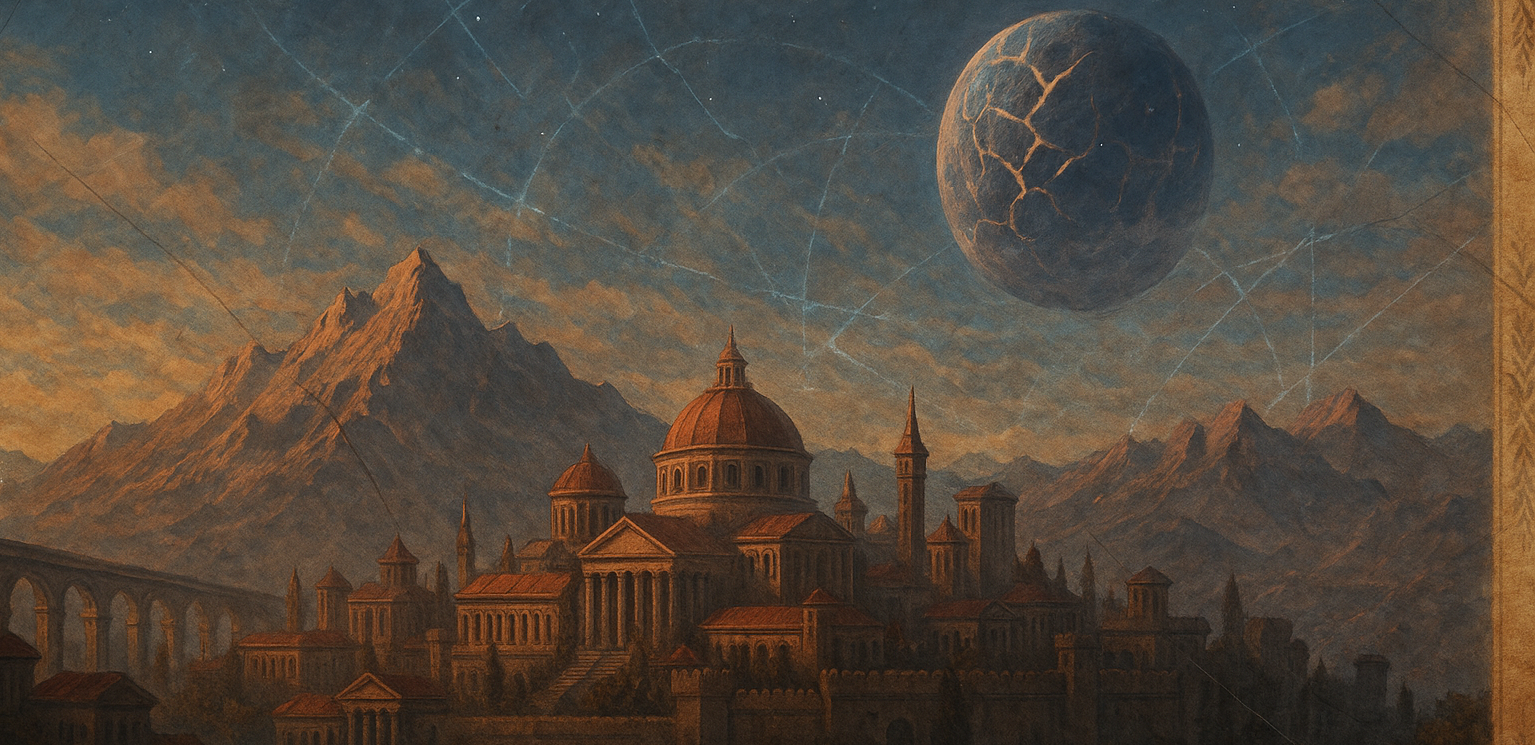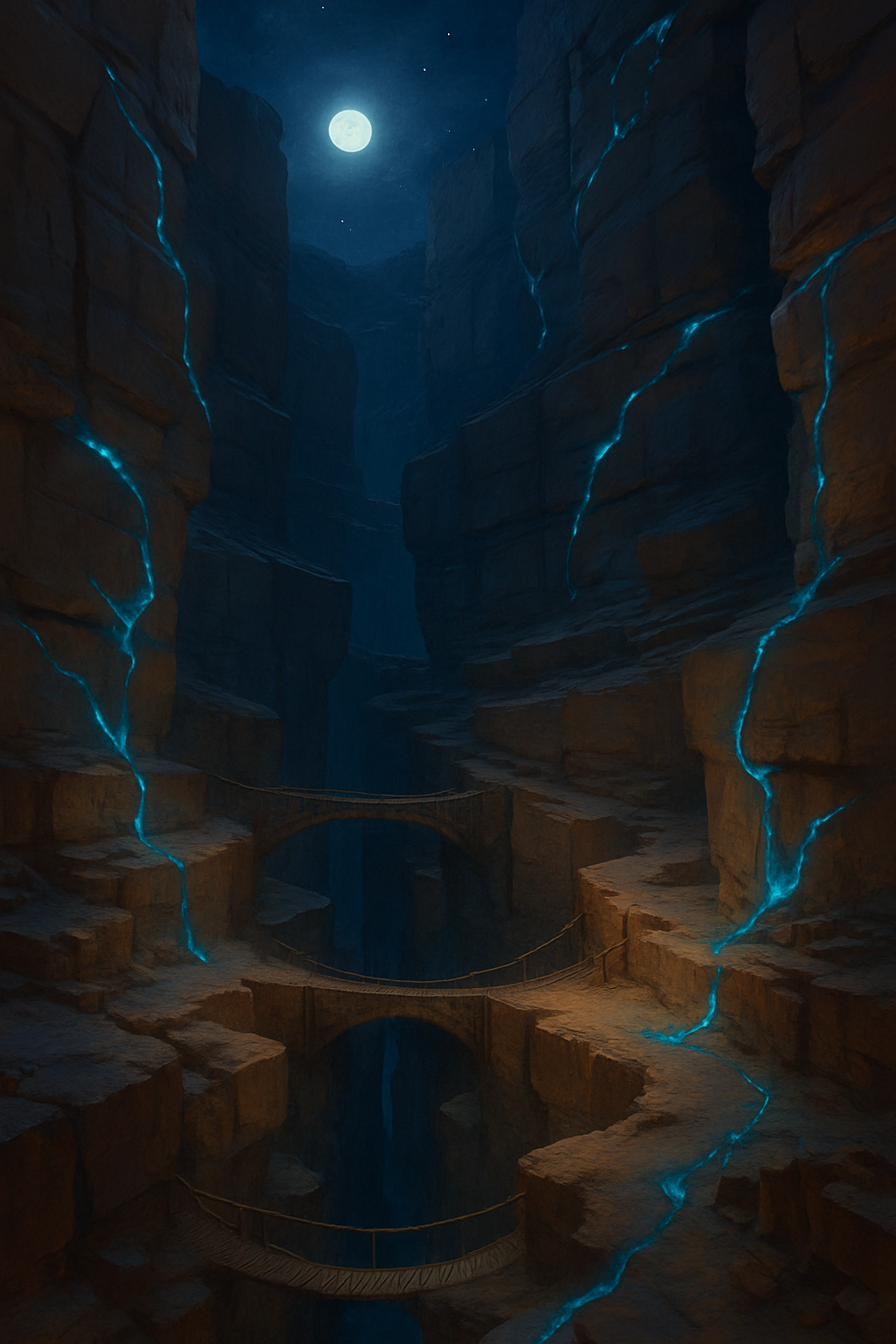The Living Labyrinth
“Stone shifts, walls whisper, paths betray. Only those who listen to the Rift can find their way.”
The Living Labyrinth is a vast canyon network that writhes and reforms with uncanny patience, a monument to the Rift’s relentless will. Carved into the earth during the Rift’s first breath, it twists and collapses over months and years, swallowing settlements, revealing hidden chambers, and sealing away once-accessible roads. Its inhabitants — hardy miners, Rift-mystics, and wandering traders — have learned to read the faint signs of change, moving their homes and markets like nomads clinging to the canyon walls. To walk the Labyrinth is to surrender to its rhythm — and hope you emerge before it swallows you whole.
Geography
The Living Labyrinth is a sprawling network of sandstone and crystal gorges that cut deep into the Riftwatch Plateau. Its walls gleam faintly under moonlight, etched with Rift-borne veins that pulse when storms approach. Bridges of stone and rope crisscross the upper reaches, while the floor sinks into narrow corridors, open plazas, and sheer drops into darkness. Above, the sky appears only in slivers, and the air is cool and still.
Ecosystem
The Labyrinth’s sheltered environment fosters strange life — mosses that glow faintly, resilient thorn-bushes, and flocks of Rift-born birds whose calls echo hauntingly through the canyon. Insects thrive in the crevices, and lean goats pick their way along perilous ledges. Occasional Riftlight pools collect in hollows, nourishing rare fungi and reeds.
Ecosystem Cycles
Over the years, entire corridors collapse and are reborn elsewhere. Inhabitants note subtle signs — walls cracking, winds shifting, glyphs glowing — as omens of imminent change. Migratory animals and people alike shift with the seasons, following the emerging paths or retreating to safer ledges during quakes and collapses.
Localized Phenomena
Every so often, a low hum fills the Labyrinth before a section begins to grind and shift, a sound known as “the Maw’s Song.” At certain dawns, Riftlight veins flare, temporarily illuminating new passages or revealing glyphs long hidden. In rare storms, crystal shards rain from the cliffs, piercing stone and soil alike.
Climate
The canyon remains cool and dry, shielded from winds and extremes. Rains are rare but sudden, pooling in hidden basins before vanishing into cracks. Riftstorms send gales and strange light into its depths, changing the very air for days after.
Fauna & Flora
Mosses, thorned vines, and Rift-reeds cling to cracks. Rift-birds with shimmering feathers and cliff-goats roam the heights. Blind salamanders inhabit the deep pools, and glowing insects flit through the night.
Natural Resources
Rich in Rift-crystals, strange fungi, and veins of ore that seem to vanish and reappear. Quarry stone is harvested from sections about to collapse. Even fragments of ancient ruins are unearthed and traded as relics.
History
The Labyrinth’s history is as enigmatic as its shifting walls. According to Riftborn legend, it was torn open during the Rift’s first breath, when the ground cracked and coiled like a living thing. Ancient glyphs carved high on its walls suggest it once housed early Riftborn cults and hermits who sought communion with the Rift’s strange power. Over centuries, wandering traders and miners discovered that its walls concealed veins of crystal and pockets of ore, and they began carving precarious dwellings into the cliffs. In time, the Labyrinth attracted guilds and Wardens who tried to chart its paths, though every map became obsolete within years. Imperial attempts to seize and tame it in the 2nd century AR met disaster — expeditions lost in collapses, whole camps swallowed overnight — and the Empire eventually declared it a place of no strategic value. Still, pilgrims, prospectors, and mystics have continued to enter its depths, leaving their own stories behind in the silent stone.
Tourism
Pilgrims come to walk its whispering paths, believing its shifting walls bring visions of ancestors and prophecy. Scholars and treasure-hunters search for hidden chambers or long-lost shrines. Brave tourists hire Wardens to guide them to the Maw’s Heart, where the Rift’s glow is said to be strongest. Visitors stay in carved inns along the safer ledges, their walls adorned with glyphs warning of collapses.




Comments